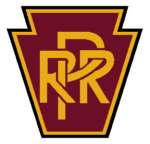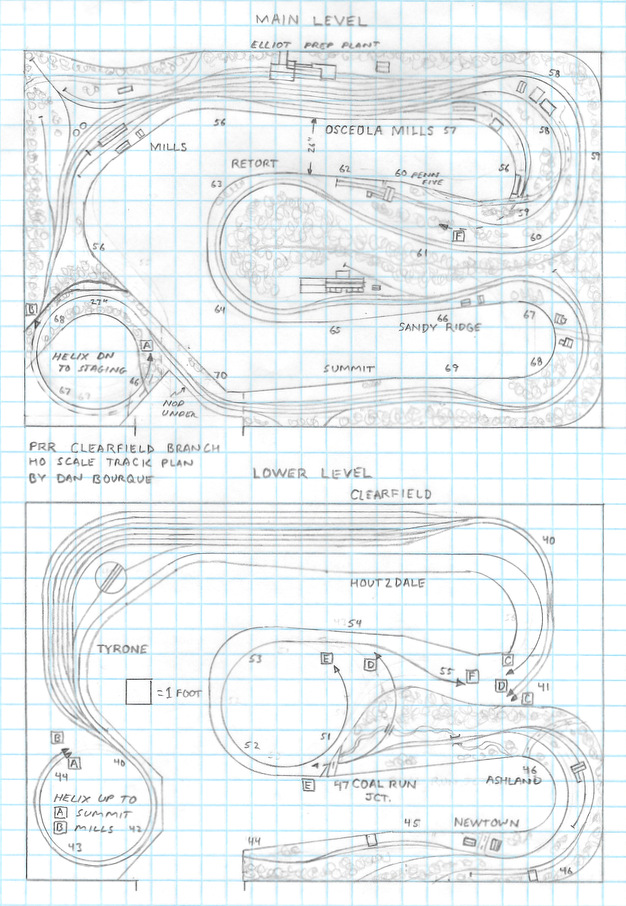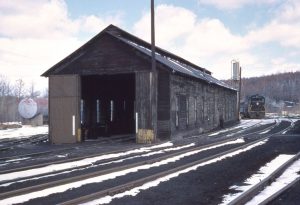- Size: 23′ x 15′
- Scale: HO
- Minimum Radius: 30″ (except 27″ on hidden helix tracks as noted)
- Minimum Aisle Width: 26″
- Designed by Dan Bourque
 The Pennsylvania Railroad’s Clearfield Branch ran from a connection with the Pennsy main near Tyrone, PA up over the Allegheny Plateau and into the rich coal fields. While the line stretched beyond Clearfield into NYC coal country, the heart of the Branch was the small yard at Osceola Mills, PA in the middle of the branch at the base of the north side of the plateau. From Osceola Mills, the Clearfield Branch continued northward toward Philipsburg and Clearfield, while the Moshannon Branch ran westward, splitting into dozens of branches that served several dozen tipples of varying sizes up every creek in the area.
The Pennsylvania Railroad’s Clearfield Branch ran from a connection with the Pennsy main near Tyrone, PA up over the Allegheny Plateau and into the rich coal fields. While the line stretched beyond Clearfield into NYC coal country, the heart of the Branch was the small yard at Osceola Mills, PA in the middle of the branch at the base of the north side of the plateau. From Osceola Mills, the Clearfield Branch continued northward toward Philipsburg and Clearfield, while the Moshannon Branch ran westward, splitting into dozens of branches that served several dozen tipples of varying sizes up every creek in the area.
The Layout
This track plan, set in the transition era, focuses on two key features of the Clearfield Branch, Osceola Yard and the 2+% climb up the north side of the Allegheny Plateau. These two features form the essence of the branch: sending out mine runs, cleaning and classifying the coal in Osceola Mills, and shoving the loaded trains up and over the helper grade. The layout is essentially a single-deck layout with a small section of double-deck underneath to allow for some mine run operations on the Coal Run Branch. The layout is built high to allow access via a nod-under (70″ track height) at the doorway. This height also allows a “railfan’s view” of the helper operations between Osceola Mills and Summit.
While Osceola Mills is compressed, all the key features are modeled including the yard, small engine facilities and wye, the Elliot Coal Company prep plant and the junction with the Moshannon Branch. To allow unrestricted visibility of the Clearfield Branch for helper operations, the Moshannon Branch is tucked behind buildings before disappearing under an overpass and under the layout. The small Trout Run Branch runs parallel to the Clearfield grade (as it did on the prototype) to the small loader at Penn Five. The town of Sandy Ridge, along the grade, is also modeled along with its sidings and industry (I’ve been told it was a brick yard). The small yard at Summit is modeled at the top of the grade, though the wye is not.
 Under Sandy Ridge and Summit is Coal Run Jct and a very truncated version of the Coal Run Branch. This scene allows for operators to see their Moshannon Branch trains between Osceola Mills and staging at Houtzdale, and it allows the modeling of three small tipples to be worked by a mine run. The staging yard is double-ended and represents the three ends of the Branch: Tyrone (PRR main), Clearfield and the many branches off the Moshannon Branch (Houtzdale). The double-ended design makes the entire layout a continuous running loop, and loads taken to Tyrone can be recycled as loads from either Clearfield or Houtzdale, bringing loads into Osceola Mills from both directions, as it was on the protoype. Tracks are between 18-20 feet long, allowing for a pair of locomotives, a cab, and about 35-45 50T hoppers. A turntable is provided to turn steam engines in staging, if desired.
Under Sandy Ridge and Summit is Coal Run Jct and a very truncated version of the Coal Run Branch. This scene allows for operators to see their Moshannon Branch trains between Osceola Mills and staging at Houtzdale, and it allows the modeling of three small tipples to be worked by a mine run. The staging yard is double-ended and represents the three ends of the Branch: Tyrone (PRR main), Clearfield and the many branches off the Moshannon Branch (Houtzdale). The double-ended design makes the entire layout a continuous running loop, and loads taken to Tyrone can be recycled as loads from either Clearfield or Houtzdale, bringing loads into Osceola Mills from both directions, as it was on the protoype. Tracks are between 18-20 feet long, allowing for a pair of locomotives, a cab, and about 35-45 50T hoppers. A turntable is provided to turn steam engines in staging, if desired.
This layout, with its helper operations, would benefit greatly from an advanced DCC system with walk-around throttles. Wireless throttles would also help keep operators from getting tangled.
Operations
This layout would need 3-5 operators for a normal transition-era operating session. A dispatcher might help keep things moving smoothly, though a spread-out timetable of trains would keep a dispatcher from being a necessity. A yardmaster would be necessary in Osceola Mills to build trains, break them down, hostle locomotives and keep cars feeding the prep plant. A helper crew would also be necessary to keep coal moving up-and-over the summit. One or two road crews would handle the mine runs, locals and shuttling trains back and forth between Osceola Mills and Tyrone, Clearfield and Houtzdale. In the transition era, power would be a mix of H-class 2-8-0s, occasional L1-class 2-8-2s and early EMD units. In the late 1950s, power would be primarily RS11s (8-9 were based in Osceola Mills).
Operations might start with a train of empties coming in from Tyrone. This train would be double-headed if steam powered, and it usually had a helper to get up the ridge to Summit, though since this grade it not modeled, the helper could be left off. It would coast down into Osceola Mills where the power would be cut off and serviced, and the empties assembled into mine runs. A mine run crew, with a similar number of locomotives, would take an assembled empty train and run it either down the Clearfield Branch or up the Moshannon Branch to staging where it could be recycled as another train of empties to Tyrone.
One mine run would also work the Coal Run Branch, setting off empties up the branch and gathering up loads for return to Osceola Mills. Another local would work the lime kilns at Sandy Ridge, taking materials and empty cars up from Osceola Mills and running the loads either back down to the yard or up to Summit to be picked up by another train. This area had a fair bit of non-coal traffic including lime, pulpwood, and small industries in Philipsburg (between Osceola Mills and Clearfield). Some of these industries are modeled, but it would be normal to see a fair number of non-coal cars in any mine run or train to/from Tyrone.
Other crews would operate in reverse, picking up trains of loaded hoppers in Clearfield/Houtzdale and running them to Osceola Mills where they would cut off their power and send it for servicing. The yardmaster would break down the train, sending some of the hoppers to the Elliot Prep Plant to be “cleaned” (loads-in, loads-out, so they could be immediately recycled as well) and blocking others into trains bound for Tyrone. Once 35-40 loads were ready for Tyrone, the loads would be split into two cuts, and a set of front-end power and a set of helpers would haul one cut up to Summit, leave it, descend the grade, then haul the second cut. Once back with the second cut, the head-end crew would reassemble the train and head to Tyrone while the helpers returned to Osceola Mills. The loaded train in Tyrone could now be recycled as another train of loads off the Clearfield Branch or Moshannon Branch. Infinite operations potential!
For variety, multiple eras could be run. In the late 1950s and early ’60s, the RS11s ran the show, and the grade was downgraded to a single track. 3-4 RS11s could handle a cut of loads up to Summit without helpers. In 1965, a Pennsylvania Power & Light unit train was instituted between a new loader at Rushton (between Osceola Mills and Clearfield near Philipsburg) and the York Haven Power Plant (through Tyrone). On the layout, this train would be 35-40 cars long and powered by 3-4 GP30s. The empties would pass through Osceola Mills and on to Clearfield Staging. In staging, the empties would need to be traded for loads, and the GP30s would bring the loaded train back up to Osceola Mills later in the session. Once in Osceola, the train would be cut in two, and the GP30s with RS-11s pushing would take half the train up to Summit, return to the yard, and take the second half up to Summit where the GP30s would reassemble the train and head toward Tyrone. Though the branches in the area still continued to produce coal, the Penn Central merger of 1968 quickly brought about the abandoning of the line between Osceola Mills and Tyrone, and the yard at Osceola Mills lost its status as a hub when most of the mine run operations were transferred to the NYC’s larger yard at Clearfield.
Things I Like About this Plan:
- Continuous running
- Infinite operations potential (though repetitive)
- Helper grade modeled well
- Good mix of yard, mainline, facilities and branches
- Long staging tracks
Things I Don’t Like About this Plan:
- Duck under (even if it’s 70″ high)
- Narrow aisles
- Could use more staging tracks, despite recycling
Reference:
Keystone Crossings – Clearfield Branch Guide
Related Products:




